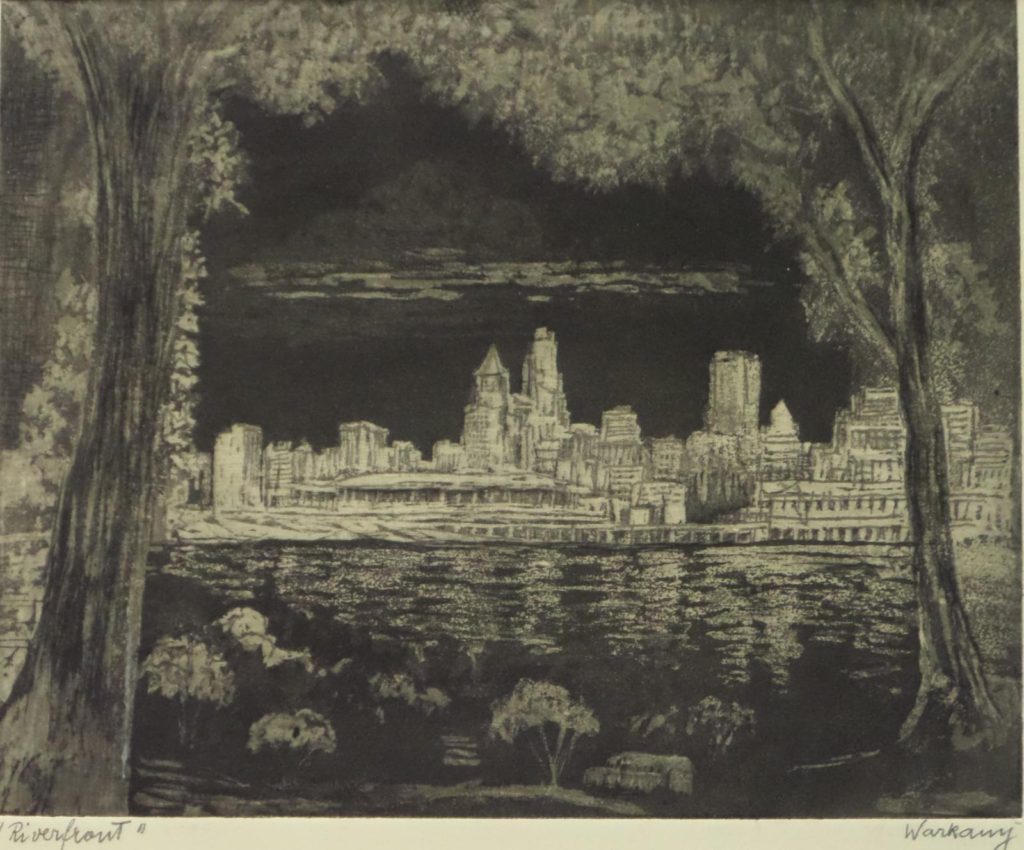Riverfront
Josef Warkany (1902-1992)
Etching
Cincinnati, OH, c. 1990
Gift of Steve F. Warkany
Josef Warkany is generally remembered for his work in medicine, not his artistic ability. His is called the father of teratology, which is the scientific study of congenital abnormalities and abnormal formations. He is renowned for his work in prenatal medicine and credited with the idea that environmental disorders can cause birth defects. Two genetic syndromes are named after him: Warkany syndrome 1 and Warkany syndrome 2 and his most notable achievements included shifting the attention of medicine to include treating the first nine months in the womb.
Born in Vienna, he studied at the medical school of the University of Vienna, but moved to Cincinnati in 1931 where he became a local hero of the medical community. In most articles written about him, his medical achievements are prominently described and his artwork, if mentioned at all, is included in a short sentence towards the bottom.
Despite the overwhelming focus on Warkany’s professional life, his etchings are charming renditions of some of the most famous scientists of the 20th century: Otto Szasz and Albert Einstein, while his images of Cincinnati and the riverfront beautifully portray aspects of the city familiar to any local. His artworks were fairly well known during his time and his work has been shown in galleries in Cincinnati as well as in the Library of Congress.
Riverfront perfectly captures the spirit of his work. It’s a nostalgic piece looking at the cityscape of Cincinnati, made only a few years before Warkany’s death in 1992. To a local Cincinnatian, this etching captures a moment in Cincinnati history right before the face of the riverfront permanently changed in the early 2000s.
Clearly visible across the water is the old Riverfront stadium, home to the Cincinnati Reds from 1970 through 2002 and the Cincinnati Bengals from 1970 to 1999. In the early 2000s, the old stadium was destroyed and two new stadiums took their place. Today, the Bengals play at Paul Brown Stadium and the Reds at Great American Ball Park and nothing remains of the old stadium that hosted so many iconic sports moments over the years.
In the background of the etching are two of the most recognizable buildings of Cincinnati’s skyline: the PNC building and Carew tower. The PNC building was the fifth-tallest building in the world when it was completed in 1913 and competed in status to the tallest skyscrapers of New York. Carew tower replaced the PNC building in 1930 as the tallest building in Cincinnati. Today, the Great American Tower is taller, but it wasn’t built until 2010, accounting for its notable absence from the etching.
The most important building of the etching; however, is the Scripps Center, a rectangular skyscraper visible in front of the triangular roof of the Duke Energy Building, which Warkany would have called the Cincinnati Gas & Electric Company Building. The inclusion of the Scripps Center is remarkable because the building was completed only two years before Warkany’s death in 1992, showing that Warkany remained active in the artistic world long after he retired from medicine.
As he stated for the May 17th, 1980 edition of The Cincinnati Enquirer, Warkany believed that “producing fine art etchings [is] as exciting as any discovery he’s made during his 48-year career as an internationally-famous medical re- searcher.” Although his biographers may have forgotten his contributions to art during his long artistic career, his etchings remain a testament to his talent and dedication to preserving slices of Cincinnati history for generations to come.

